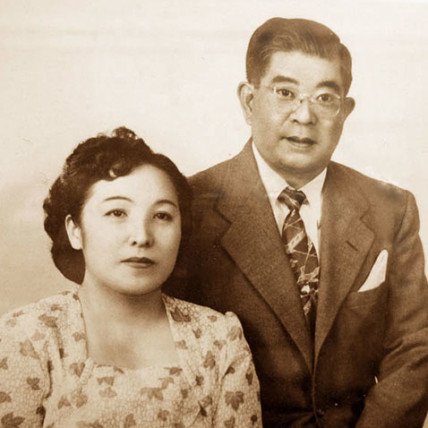Have you ever tasted the irresistible sweetness of krofne, those pillowy Eastern European donuts that melt in your mouth? These delectable treats will transport your taste buds straight to the heart of Croatia.
Krofne (pronounced krof-neh) are traditional Croatian donuts typically filled with jam, chocolate, or custard. They’re a beloved staple during carnival season, especially before Lent, when families gather to fry batch after batch of these golden-brown delights. Unlike American donuts, krofne are yeast-raised, giving them an incredibly soft, airy texture that’s simply divine.
You’ll fall in love with the simple pleasure of biting into a warm krofne dusted with powdered sugar. The contrast between the slightly crisp exterior and fluffy interior creates a perfect harmony that’s been cherished for generations. Whether you’re exploring Croatian cuisine or simply craving something sweet, these homemade donuts are worth every minute spent making them.
What Are Krofne? Traditional Croatian Donuts
Krofne (pronounced KROHF-neh) are beloved Croatian donuts that have been a cornerstone of traditional Balkan pastry for generations. These pillowy soft fried delights feature a golden crisp exterior that gives way to an airy interior with each bite. Unlike American-style donuts with holes these European treats are round and typically filled with sweet surprises.
Traditional krofne contain a distinctive filling of rose hip jam or plum preserves though modern variations include chocolate Nutella vanilla custard or apricot jam. The yeast-leavened dough gives these donuts their characteristic light texture making them distinctly different from cake-based donut varieties.
Croatian families prepare these treats year-round but they hold special significance during carnival season (Fašnik) before Lent. During this festive period krofne appear in every bakery home kitchen and street stand throughout Croatia and neighboring countries. Their presence signals celebration and indulgence before the traditional fasting period.
The perfect krofne sports a pale ring around its middle known as the “white belt” which indicates proper rising and frying technique. This distinctive feature is the mark of an expertly made donut that has been handled with care during preparation and cooking.
Beyond Croatia similar versions exist throughout Eastern Europe including Polish pączki Serbian krofne and German Berliner. Each country puts its unique spin on these fried delicacies but the Croatian version stands out for its exceptionally light texture and generous filling.
Making krofne requires patience as the dough needs proper time to rise but the result is worth every minute of waiting. The process creates not just a sweet treat but also fills your home with an irresistible aroma that has drawn Croatian families to the kitchen for centuries.
Why You’ll Love This Krofne Recipe
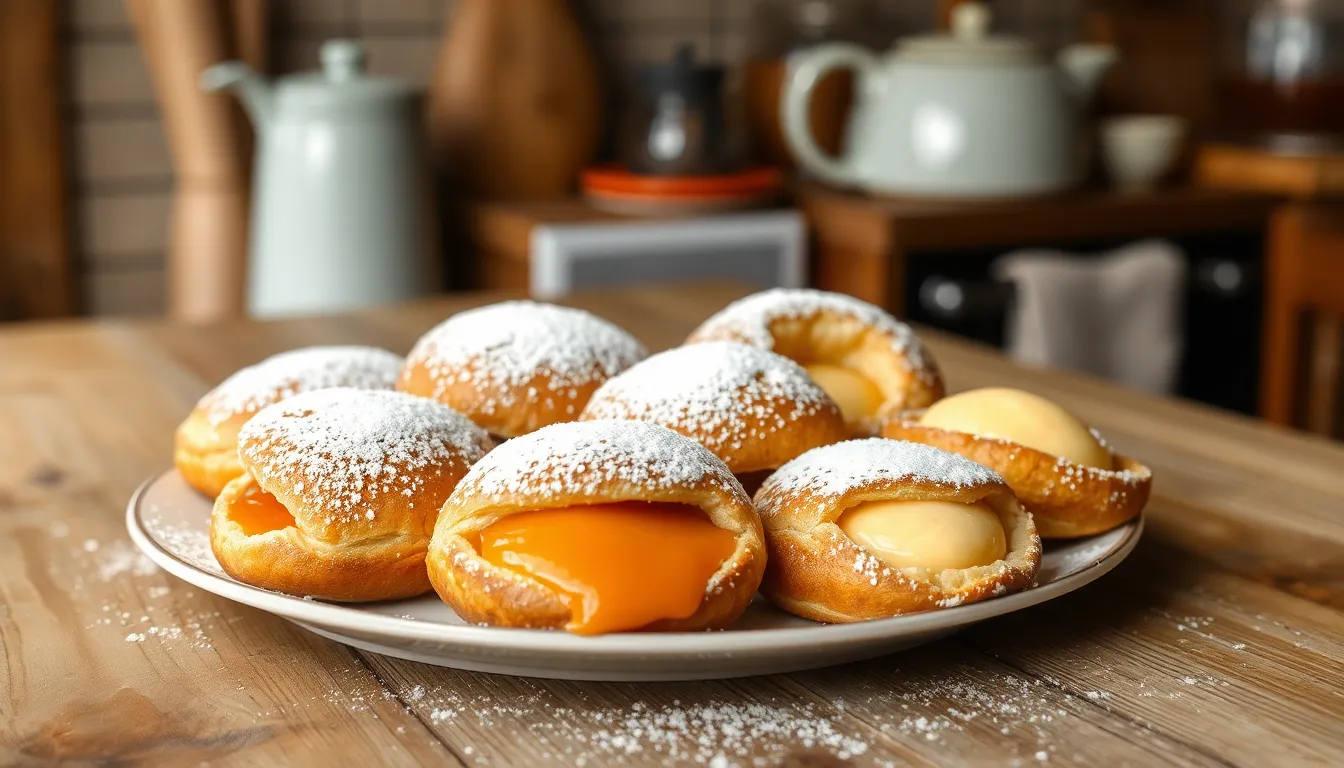
Soft and Pillowy Texture awaits with every bite of these Croatian doughnuts—the dough is remarkably soft, comparable to luxury hotel pillows. Your taste buds will delight in their delicate airy consistency that simply melts in your mouth.
Flavorful Ingredients elevate these treats beyond ordinary doughnuts. The dough incorporates subtle lemon zest and a splash of rum or brandy, creating aromatic notes that transform a simple pastry into something truly special.
Versatility makes this recipe a keeper in your collection. Traditional krofne feature apricot jam or chocolate filling, but you can experiment with vanilla custard or various fruit preserves. Regional variations from Slavonia even feature a dollop of jam on top rather than inside.
Golden Perfection is achieved when these doughnuts puff beautifully during frying, developing that coveted golden-brown exterior. Look for the distinctive thin white ring (called “ramftl” by locals in Zagreb)—a telltale sign your krofne are properly fried.
Sweet Finish completes these delightful pastries. A generous dusting of powdered sugar or rolling in caster sugar adds the perfect sweet crust that contrasts wonderfully with the tender interior.
Comfort and Tradition fill your kitchen when making krofne at home. The irresistible aroma creates a festive atmosphere that brings together family and friends. These beloved treats appeal to both children and adults, making them perfect for celebrations and especially during Carnival season.
Ingredients You’ll Need
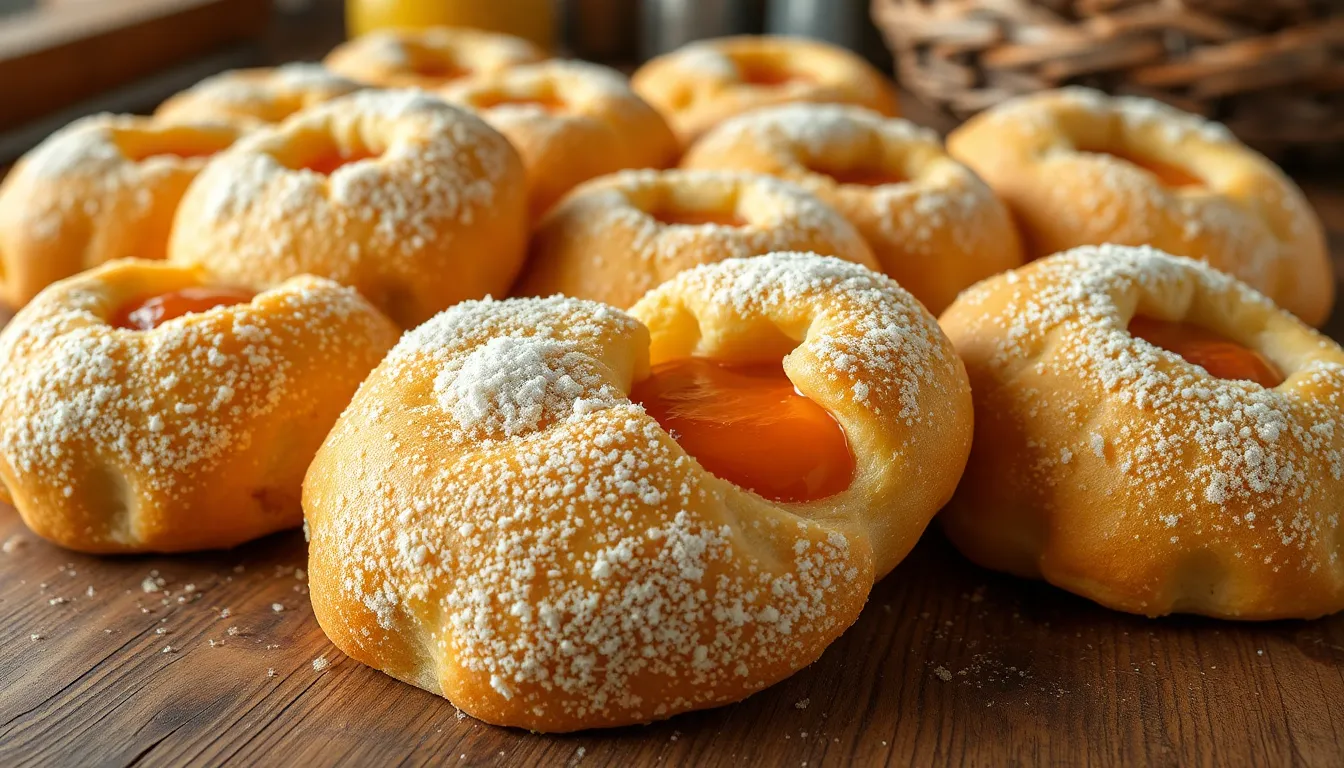
Gathering the right ingredients is crucial for authentic Croatian krofne with their signature pillowy texture and golden exterior. These traditional doughnuts require basic pantry staples but benefit from a few special additions that elevate their flavor.
For The Dough
- 1.5 tablespoons active dry yeast
- 2 tablespoons granulated sugar
- 1.75 cups warm milk (77-86°F)
- 3.75 to 4 cups all-purpose flour
- 5 egg yolks
- 1 tablespoon vegetable oil
- ½ teaspoon salt
- 1 tablespoon rum or brandy
- Zest of one lemon
- Vegetable oil for frying (enough to fill your pot 2-3 inches deep)
The key to perfect krofne dough lies in the temperature of your milk—it should be warm but not hot to activate the yeast properly. Adding lemon zest brings a subtle brightness that balances the richness of the dough. Your splash of rum or brandy might seem unusual but contributes an aromatic depth that distinguishes authentic Croatian krofne from ordinary doughnuts.
For The Filling
- 1 cup apricot jam (traditional choice)
- Strawberry jam (popular alternative)
- Nutella (modern variation)
- Vanilla pastry cream (optional variation)
Traditional Croatian krofne typically feature fruit jams with apricot being the most authentic choice. You can prepare your filling ahead of time and have it ready at room temperature for easier piping. Regional variations might include rose hip jam or plum preserves depending on family traditions and seasonal availability.
For The Topping
- ¼ cup granulated sugar
- 2 tablespoons powdered sugar
- 1 teaspoon vanilla sugar (if available)
The finishing touch for your krofne should be applied while they’re still warm to ensure proper adhesion. Most Croatian families prefer a simple coating of granulated sugar which creates a pleasant crunch against the soft dough. Powdered sugar offers a more delicate presentation particularly appealing for special occasions. Some bakers combine both powdered sugar and vanilla sugar for an aromatic sweet finish that enhances the overall experience.
Equipment Needed

Preparing authentic Croatian krofne requires several essential kitchen tools to achieve those perfectly fluffy, golden-brown donuts. Gather these items before starting your krofne-making adventure:
- Stand mixer with dough hook attachment – Makes the kneading process significantly easier and develops proper gluten structure for that characteristic airy texture. While not absolutely necessary, it saves considerable time and effort compared to hand kneading.
- Deep pot or fryer – Choose a heavy-bottomed pot at least 4-5 inches deep for safe frying that maintains consistent oil temperature. A dedicated deep fryer works wonderfully if available.
- Kitchen cloths or tea towels – These are crucial for covering your dough during the rising periods, helping maintain moisture and warmth for optimal yeast development.
- Glass or round cutter (approximately 3 inches in diameter) – Ensures uniform donut shapes for even cooking. A drinking glass works perfectly if you don’t have a dedicated cutter.
- Wooden spoon – Useful for initial mixing and for safely checking donuts while frying.
- Kitchen scale – Precision matters in baking! Measuring ingredients by weight rather than volume significantly improves consistency and results.
- Slotted spoon or spider strainer – Essential for safely removing hot krofne from oil while allowing excess oil to drain.
- Paper towels – Place these on a plate or tray to absorb extra oil after frying.
- Candy or frying thermometer – Optional but helpful for monitoring oil temperature, which should stay around 350°F (175°C) for perfect krofne.
- Piping bag with long tip – Necessary if you plan to fill your krofne with jam, custard, or other delicious fillings after frying.
Setting up your workspace with all these tools before beginning ensures a smooth process from mixing to the final dusting of sugar on your warm, freshly-made Croatian donuts.
How To Make Krofne

Creating these traditional Croatian donuts requires patience and attention to detail. Follow these steps to achieve soft pillowy krofne with the perfect white ring.
Preparing The Dough
Start by activating your yeast in warm milk mixed with a little flour. Stir the mixture well and let it sit for 10-15 minutes until it becomes frothy and doubles in size. In a large bowl or stand mixer, combine flour, sugar, salt, and citrus zest for added flavor. Form a well in the center of your dry ingredients and pour in the bloomed yeast mixture, egg yolks, rum (or brandy), and oil or butter. Knead the dough for 15-20 minutes on low speed until it becomes smooth, soft, and elastic. Avoid adding extra flour during this process to maintain the light texture that makes krofne special.
First Rise
Shape your freshly kneaded dough into a ball and transfer it to an oiled bowl. Cover the bowl with a damp cloth or plastic wrap to prevent the surface from drying out. Place the covered dough in a warm spot or inside a turned-off oven that was preheated to about 80-100°F (27-37°C). Let the dough rise for 1-2 hours until it doubles in size. This initial proofing period develops the flavor and texture essential to authentic krofne.
Shaping The Donuts
After the first rise, gently punch down the dough to release excess air bubbles. Divide the dough into two equal portions for easier handling. Roll out one portion to approximately 2 cm thickness on a lightly floured surface. Use a round cutter (3-6 inches in diameter) or a drinking glass to cut out circles from the dough. Gather the scraps and re-knead them briefly before rolling out again. Continue this process until you’ve used all the dough.
Second Rise
Place your cut dough circles on a floured surface or clean kitchen towel, ensuring they have space between them to expand. Cover the circles loosely with another towel and allow them to rise again for 20-30 minutes. The donuts should look visibly puffed up when ready. This second rise is crucial for achieving the fluffy interior texture that makes krofne so delightful.
Frying The Krofne
Heat vegetable oil in a deep pot to 80-100°C (176-212°F). Carefully lower a few krofne into the hot oil, making sure not to overcrowd the pot. Fry them covered for about one minute until the bottom side turns golden. Remove the lid and flip them over to fry the other side for another minute. Look for the characteristic white ring (known as “ramftl” in Zagreb) around the middle of each krofne, indicating they’re perfectly cooked. This distinctive white belt is the hallmark of properly made krofne.
Filling And Finishing
Remove the fried krofne with a slotted spoon and place them on paper towels to drain excess oil. Allow them to cool slightly before filling. Load a cooking syringe or piping bag with traditional apricot or plum jam. Insert the tip into the side of each krofne and squeeze gently to fill the center with jam. Roll the filled krofne in granulated sugar or dust them generously with powdered sugar. Serve your krofne while still warm for the most authentic experience of this beloved Croatian treat.
Tips For Perfect Krofne
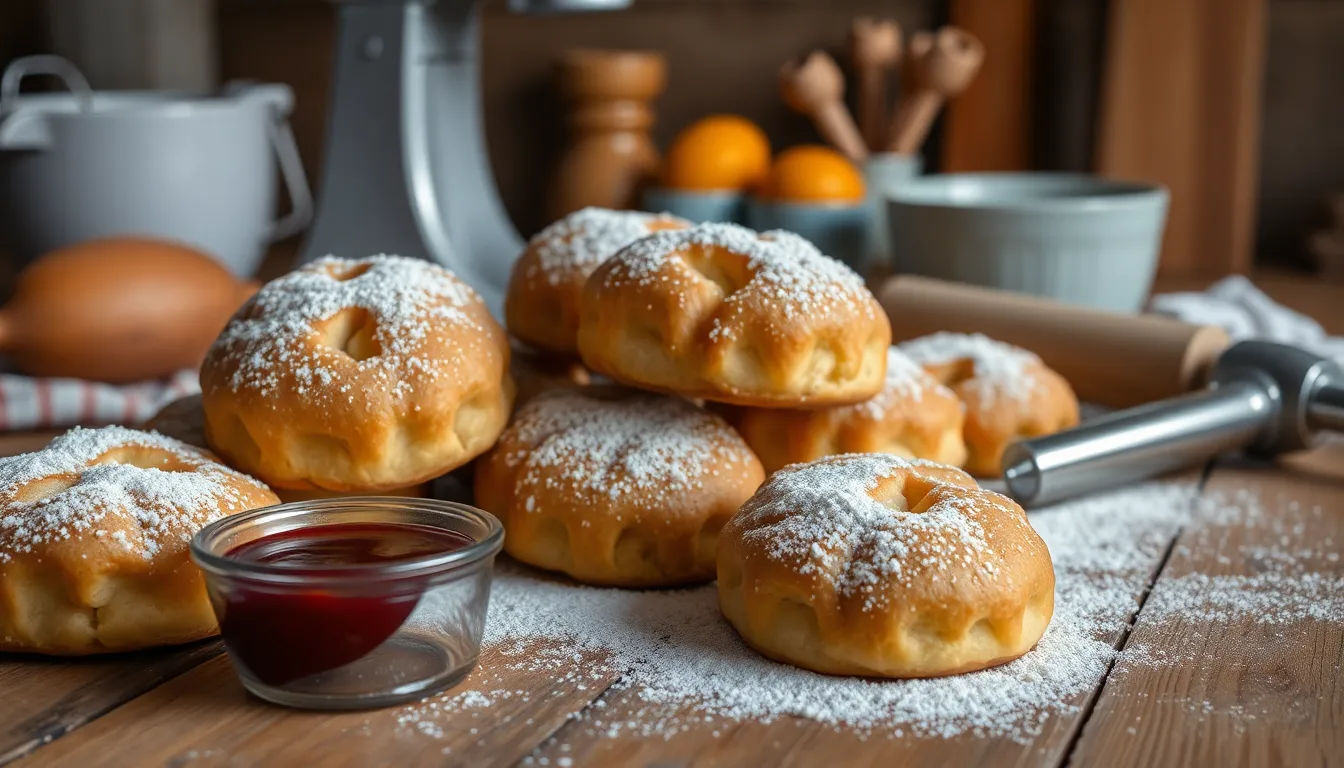
Control Your Dough Consistency
Achieving the perfect krofne starts with proper dough consistency. Your dough should feel soft and elastic to the touch but not sticky. Use a stand mixer with a dough hook for thorough kneading, as this helps develop the gluten properly and creates that signature pillowy texture. When adding flour, do so gradually to avoid making the dough too stiff, which would result in dense rather than fluffy krofne.
Master the Rising Process
Keep your kitchen warm while the dough rises to aid fermentation and volume increase. The dough should double in size during the first rise, which typically takes about an hour depending on room temperature. After shaping your krofne, allow them to rise again until they look puffy and light. This second rise is crucial for developing those airy pockets that make krofne so delightful.
Perfect Your Frying Technique
Heat your oil to about 80-100°C for optimal results. Begin frying with a lid covering the pot for approximately one minute until the bottom side turns golden brown. Then remove the lid and continue frying uncovered until the top side also achieves that beautiful golden color. This technique helps develop the characteristic white ring or “ramftl” near the edge that indicates a perfectly fried krofne.
Fry Patiently and Separately
Avoid overcrowding your frying vessel. Fry the doughnuts separately to prevent them from sticking together and to ensure even cooking throughout. Using a slotted spoon, gently place the dough rounds into the oil and flip them only once during the frying process. This patient approach yields krofne with an evenly crisp exterior and fluffy interior.
Add Flavor Enhancers
Incorporate a touch of rum or brandy into your dough for an authentic aroma that elevates your krofne beyond ordinary doughnuts. Lemon zest provides a subtle brightness that balances the sweetness. These traditional additions might seem minor but significantly impact the final flavor profile of your krofne.
Fill While Warm
For jam-filled varieties, use a cooking syringe to inject your preferred filling while the krofne are still warm. This allows the filling to distribute evenly throughout the interior. In Slavonian tradition, you may alternatively place a dollop of jam on top rather than filling the center.
Finish With the Perfect Coating
After draining excess oil with paper towels, dust your krofne lightly with powdered sugar for a classic finish. For a special touch, mix granulated sugar with vanilla sugar to create a more aromatic coating. Apply the sugar while the krofne are still slightly warm so it adheres properly to the surface.
Serve at the Right Moment
Krofne taste best when served slightly warm, when the contrast between the crisp exterior and soft interior is most pronounced. If you’ve made them in advance, warm them gently before serving to revive their freshly-made texture and aroma.
Variations And Fillings
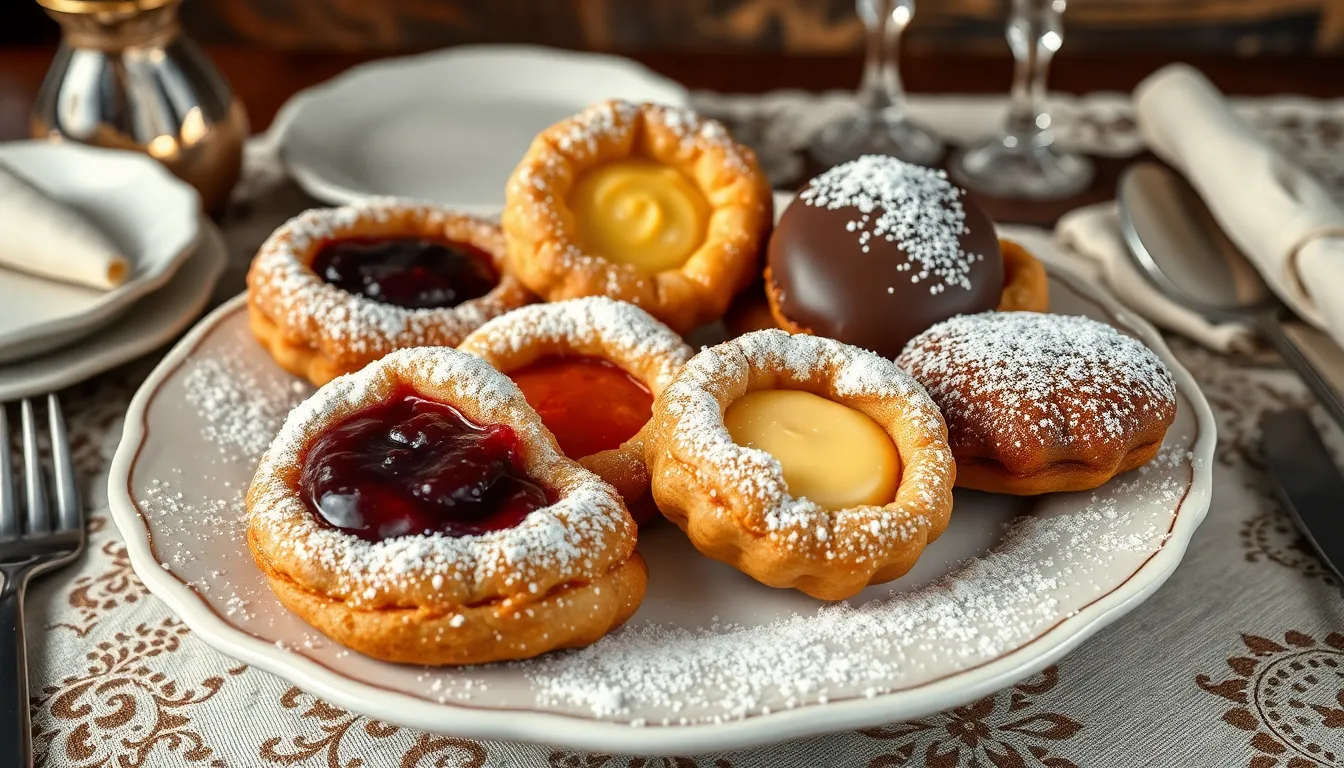
Traditional krofne offer endless possibilities for fillings that transform these airy Balkan doughnuts into personalized treats. Each filling variation creates a unique flavor experience while maintaining the signature fluffy texture that makes krofne so beloved.
Jam-Filled Krofne
The classic version of krofne features warm homemade fruit jams that create a delightful contrast to the pillowy dough. Plum and apricot preserves rank among the most traditional options offering a sweet fruity burst with each bite. These jam-filled treats are typically dusted with a generous layer of powdered sugar improving their visual appeal and adding extra sweetness. Children particularly adore this variation which embodies the authentic Balkan krofne experience. For the best results use quality preserves with chunks of real fruit rather than overly processed options to maintain the traditional character of this beloved pastry.
Custard-Filled Krofne
Vanilla custard transforms krofne into a creamy indulgence that perfectly complements the light airy dough. The smooth custard filling provides a rich mouthfeel and subtle flavor that isn’t overwhelmingly sweet. You can prepare homemade pastry cream or vanilla pudding for an authentic experience that elevates these doughnuts to special-occasion status. Many bakeries throughout Serbia Croatia and neighboring countries offer this variation as a popular alternative to jam-filled versions. The custard should be thick enough to stay inside the krofne yet soft enough to create that coveted creamy center when you take your first bite.
Chocolate Krofne
Chocolate lovers rejoice with this decadent variation that features rich chocolate fillings from ganache to Nutella. The intense chocolate flavor pairs wonderfully with the subtle sweetness of the krofne dough creating an irresistible combination. Some versions incorporate chocolate icing on top alongside the traditional powdered sugar dusting for an extra indulgent experience. Nutella-filled krofne have gained immense popularity in recent years offering that perfect hazelnut chocolate flavor that appeals to both children and adults. For an extra special treat warm your krofne slightly before serving to allow the chocolate filling to become delightfully gooey and even more satisfying.
How To Store Krofne
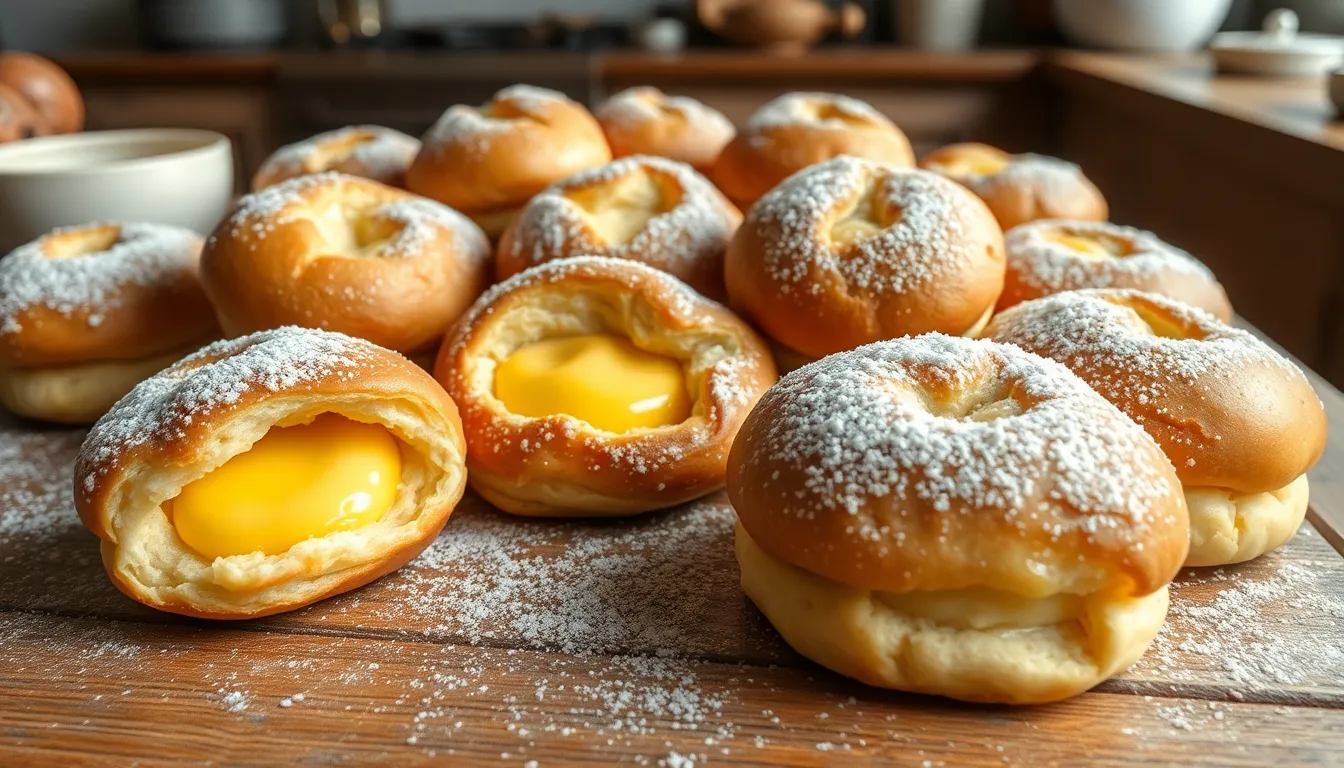
Proper storage is essential to maintain the freshness and delightful texture of your homemade krofne. These Balkan doughnuts require exact storage methods depending on whether they’re filled or plain.
For krofne filled with custard or cream, refrigeration is necessary to preserve their quality. Place them in an airtight container and cover with plastic wrap, ensuring the wrap makes direct contact with any exposed custard to prevent a skin from forming. This technique locks in moisture and prevents the filling from drying out.
Plain unfilled krofne can be stored at room temperature in an airtight container for 1-2 days. Their texture remains best when they’re kept away from moisture and direct sunlight.
When storing custard separately for later use, always press plastic wrap directly onto its surface before refrigerating. This simple step prevents that unwanted skin layer from developing on top of your creamy filling.
Refrigerated krofne should be consumed within 2-3 days for optimal taste and texture. Beyond this timeframe, both the dough and filling begin to deteriorate in quality.
Revive day-old krofne by warming them briefly in an oven or air fryer before serving. A quick 2-3 minute warm-up at low temperature can restore much of their original texture and enhance their flavor profile.
Remember that these traditional treats are truly at their peak when enjoyed fresh, ideally within hours of frying. The contrast between the crisp exterior and fluffy interior diminishes somewhat with storage, though proper techniques help preserve their delightful qualities as much as possible.
Make-Ahead Instructions
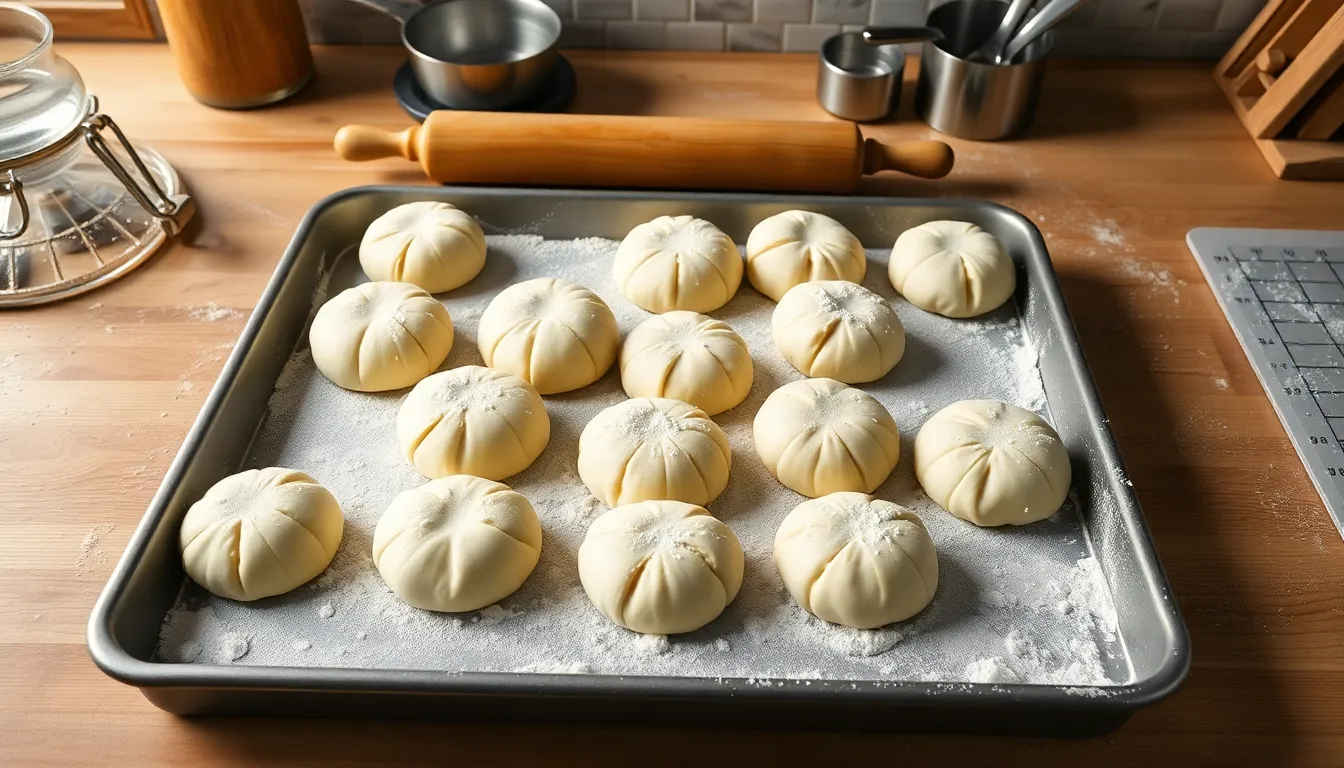
Planning to serve freshly made krofne without the last-minute rush? These Croatian doughnuts can be prepared in advance with proper timing and techniques. Follow these strategies to enjoy warm krofne whenever the craving strikes.
Prepare the Dough in Advance
Mix and knead your krofne dough up to 24 hours before frying. After the initial kneading process, place the dough in a large oiled bowl and cover it tightly with plastic wrap. Store the covered dough in the refrigerator overnight for a slow first rise that enhances flavor development. Remove the dough from refrigeration 1-2 hours before shaping to allow it to warm to room temperature.
Shaped Dough Storage
Cut and shape your krofne rounds then arrange them on a floured tray with enough space between each piece. Cover the tray loosely with a kitchen cloth to prevent drying. Allow the shaped dough to rise for just 10-15 minutes before transferring the tray to the refrigerator. Refrigerate for up to 8 hours before frying day.
Frying Preparations
Remove your shaped krofne from the refrigerator approximately 30-45 minutes before frying. This warming period allows the dough to complete its second rise at room temperature. Heat your oil to the proper temperature while the dough warms up. For best results, only fry krofne when they’ve returned to room temperature and have slightly puffed.
Partially Fried Storage Option
For an ultra-quick finish later, you can partially fry krofne until they’re just light golden. Cool them completely then store in an airtight container at room temperature for up to 12 hours. When ready to serve, finish frying them for 1-2 minutes until they reach the desired golden brown color with the characteristic white belt.
Fully Prepared Storage
Completely fried krofne can be stored in plastic containers in the refrigerator for 2-3 days or frozen for up to one month. Leave them unfilled and undusted with sugar for best storage results. Reheat refrigerated krofne briefly in a microwave for 10-15 seconds or in a 300°F oven for 3-5 minutes to restore their softness before filling and dusting with powdered sugar.
Filling Ahead of Time
Prepare your jam fillings or custards up to three days in advance and store them separately in the refrigerator. Only fill your krofne just before serving for the freshest taste and texture. Warm thick jam slightly before filling to achieve smoother piping consistency.
Serving Suggestions
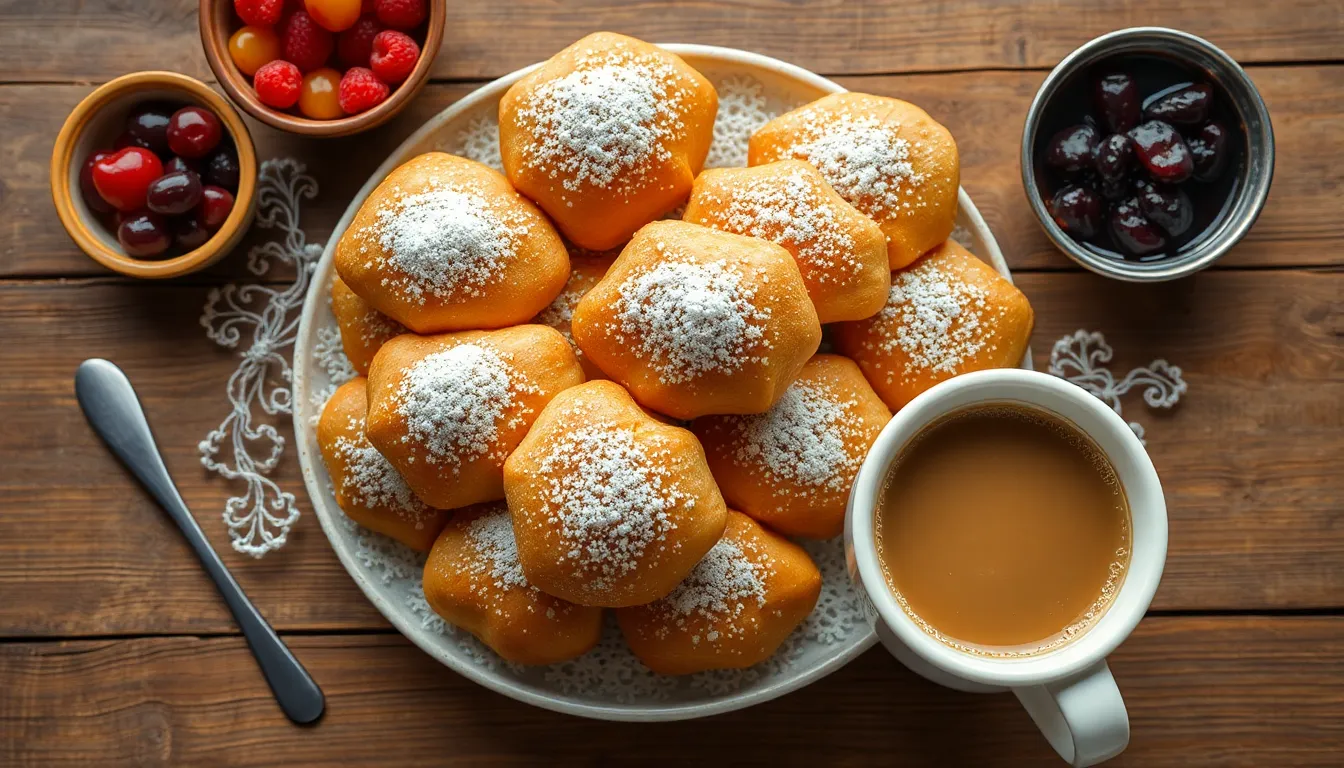
Traditional krofne presentation transforms these Eastern European doughnuts into irresistible treats worth savoring. Dust your freshly fried krofne with a generous layer of powdered sugar for an elegant finish that enhances their visual appeal while adding sweetness. Many households serve krofne with a classic filling of apricot or plum jam which celebrates their Balkan heritage.
For contemporary tastes try these popular serving variations:
- Pair unfilled krofne with small bowls of various jams chocolate spread and custard allowing guests to customize their treats
- Create a dessert platter with krofne alongside seasonal fruits and a pot of strong coffee or tea
- Serve warm krofne for breakfast with a dollop of yogurt and honey for a satisfying morning treat
- Arrange krofne on a decorative platter dusted with cinnamon-sugar for festive occasions
The white belt or “ramftl” around the middle of properly fried krofne serves as a badge of authenticity that seasoned bakers look for before presenting these pastries. During carnival season krofne become centerpieces at celebration tables symbolizing indulgence before the fasting period of Lent.
Temperature matters significantly when serving krofne. These pastries reach their peak deliciousness when served slightly warm allowing the contrast between the crisp exterior and pillowy interior to shine through. Filled versions particularly those with chocolate or Nutella benefit from warmth which creates an irresistibly gooey center that flows with each bite.
The History Of Krofne In Croatian Cuisine
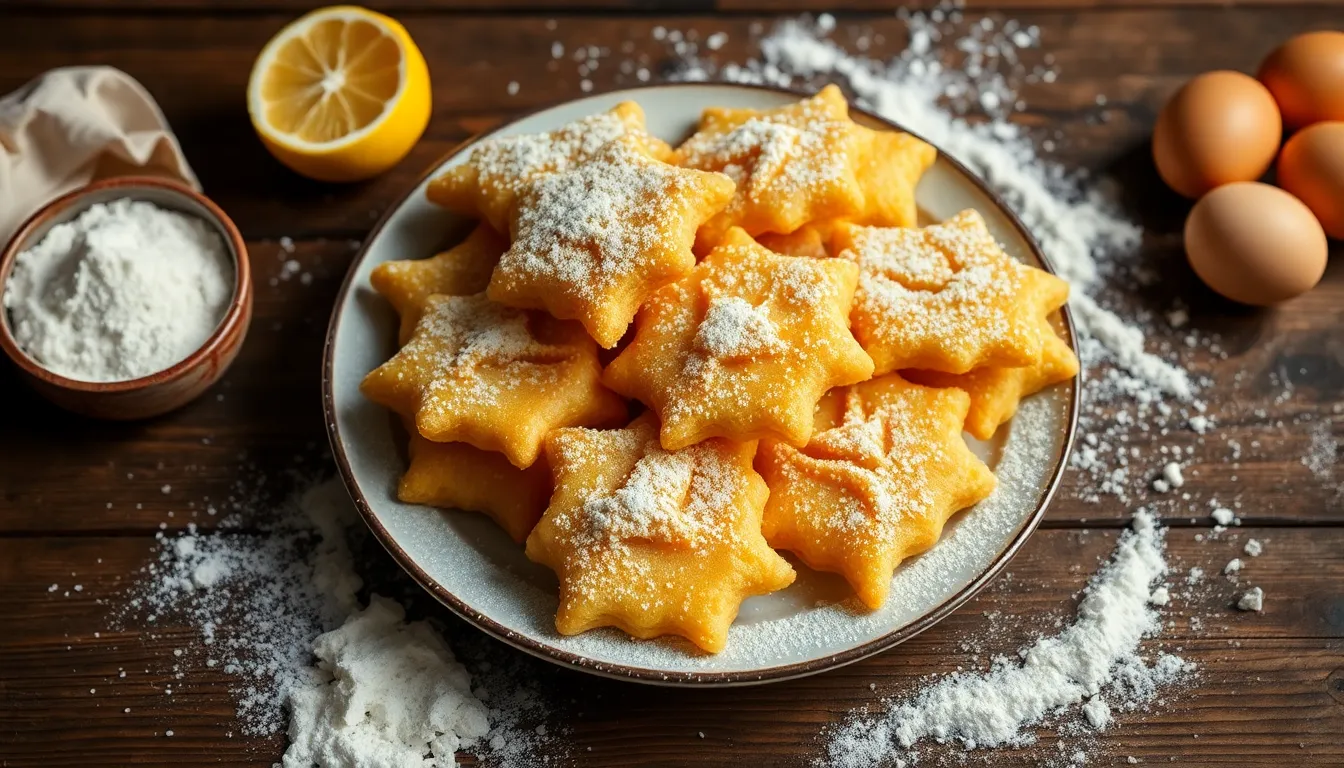
Croatian krofne trace their origins to the period of Austro-Hungarian rule when these pillowy delights first made their way into Croatian kitchens. The name “krofne” itself derives from the German word “Krapfen” which refers to a similar style of filled doughnut popular throughout Central Europe.
Austrian influence played a important role in krofne’s introduction to Croatia. Cecilia Krapf the Emperor’s pastry chef shared the recipe with street food vendors which helped spread these delectable treats across Europe including Croatia. This cultural exchange during the Habsburg monarchy established krofne as a beloved pastry that would become deeply integrated into Croatian culinary traditions.
Krofne hold special significance during Croatia’s carnival season when they’re known as “pokladnice.” These festive doughnuts became an essential part of pre-Lent celebrations typically enjoyed during mid-winter festivities. They also feature prominently at Croatian Christmas markets particularly in Zagreb where their sweet aroma draws visitors to market stalls.
The traditional recipe for krofne reflects their rich heritage featuring a soft airy dough made with flour eggs sugar yeast and aromatic additions. Many Croatian families enhance their krofne with distinctive flavors like lemon peel vanilla sugar and occasionally a splash of rum or plum brandy (Šljivovica) to create a uniquely Croatian version of this Central European treat.
While maintaining their historical roots Croatian krofne have evolved over generations with regional variations in fillings and preparation methods. Traditional fillings include various fruit jams and marmalades though modern versions might contain chocolate Nutella or sweet custard fillings that cater to contemporary tastes.
These golden-fried doughnuts represent more than just a sweet indulgence—they embody Croatia’s historical connection to Central European culinary traditions while showcasing distinctive local adaptations. The enduring popularity of krofne demonstrates how food traditions can preserve cultural heritage through generations as Croatian families continue to prepare these treats according to recipes passed down through the years.
Conclusion
Krofne represent more than just delicious donuts—they’re a delightful window into Croatian culture and tradition. Whether you choose classic jam fillings or modern chocolate variations you’ll appreciate the distinctive white belt that marks perfect frying technique.
The magic of krofne lies in their contrasts: crisp exterior giving way to pillowy softness inside. With the right equipment and a bit of patience your kitchen can transform into a space where generations of tradition come alive.
From carnival celebrations to family gatherings these beloved treats continue to bring people together. So dust with powdered sugar serve slightly warm and watch as your homemade krofne create memorable moments around your table just as they’ve done in Croatian homes for centuries.
Frequently Asked Questions
What are krofne?
Krofne are traditional Croatian donuts known for their pillowy texture and sweet flavor. These yeast-raised treats feature a golden crisp exterior and a fluffy interior, typically filled with jam, chocolate, or custard. Pronounced KROHF-neh, they’ve been a cornerstone of Balkan pastry for generations and are especially popular during carnival season before Lent.
What is the white belt or “ramftl” on krofne?
The white belt or “ramftl” is a distinctive pale ring that appears around the middle of properly made krofne. This feature indicates that the dough has risen correctly and been fried at the right temperature. Professional bakers and home cooks alike consider this white ring a mark of quality and proper technique in krofne preparation.
When are krofne traditionally eaten in Croatia?
While krofne are enjoyed year-round in Croatia, they hold special significance during carnival season (Fašnik) before Lent. During this time of celebration and indulgence, krofne symbolize the festive spirit. They’re also popular at Christmas markets and family gatherings, representing a sweet tradition that brings people together for celebrations.
What are traditional fillings for krofne?
Traditional krofne fillings include rose hip jam and plum preserves (pekmez). However, modern variations feature a wide range of options such as apricot jam, chocolate ganache, Nutella, and vanilla custard. Some regional variations even place jam on top rather than inside. The filling is typically added after frying while the krofne are still warm.
How long do krofne stay fresh?
Unfilled krofne can be stored at room temperature for 1-2 days in an airtight container. Filled krofne, especially those with custard or cream, should be refrigerated and consumed within 2-3 days for optimal quality. Day-old krofne can be briefly warmed in an oven or air fryer to restore their texture and freshness.
Can krofne dough be prepared in advance?
Yes, krofne dough can be prepared up to 24 hours before frying. After mixing and kneading, allow for a slow first rise in the refrigerator. Shaped dough can also be stored briefly before frying. While the dough can be prepared ahead, fillings should be added just before serving for the freshest taste and best texture.
What equipment is needed to make krofne?
Essential equipment includes a stand mixer with a dough hook, a deep pot or fryer, kitchen cloths for covering the rising dough, a glass cutter or round cookie cutter for shaping, a wooden spoon, kitchen scale, and a slotted spoon. Optional tools include a candy thermometer to monitor oil temperature and a piping bag for filling the krofne.
How are krofne different from other European donuts?
Croatian krofne are celebrated for their exceptionally light texture and generous filling compared to similar Eastern European varieties. Their distinctive white belt sets them apart visually. The dough often includes flavor enhancers like lemon zest and rum or brandy, giving them a unique taste profile compared to other European donuts like German Berliner or Polish pączki.
What’s the best way to serve krofne?
Krofne are best served slightly warm, allowing the contrast between the crisp exterior and soft interior to shine. Traditionally dusted with powdered sugar, they pair wonderfully with coffee or tea. For a more elaborate presentation, create dessert platters with various fillings on the side or serve for breakfast with yogurt and honey.
What is the origin of krofne in Croatian cuisine?
Krofne were introduced to Croatian kitchens during the Austro-Hungarian period, with the name derived from the German “Krapfen.” They became integral to Croatia’s carnival celebrations as “pokladnice” and represent Croatia’s historical ties to Central European culinary traditions. Over generations, Croatians have adapted the recipe with local flavors while preserving this important cultural heritage.

